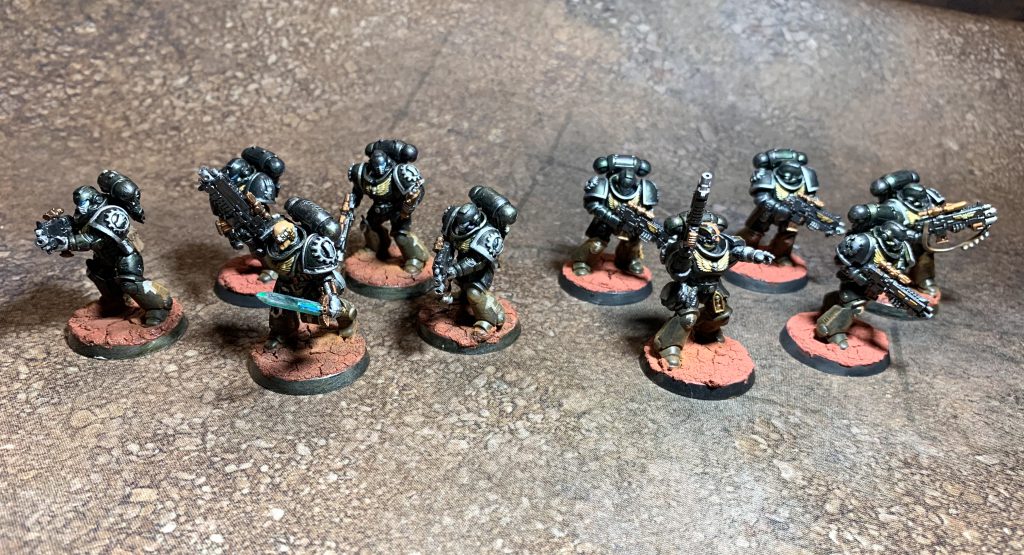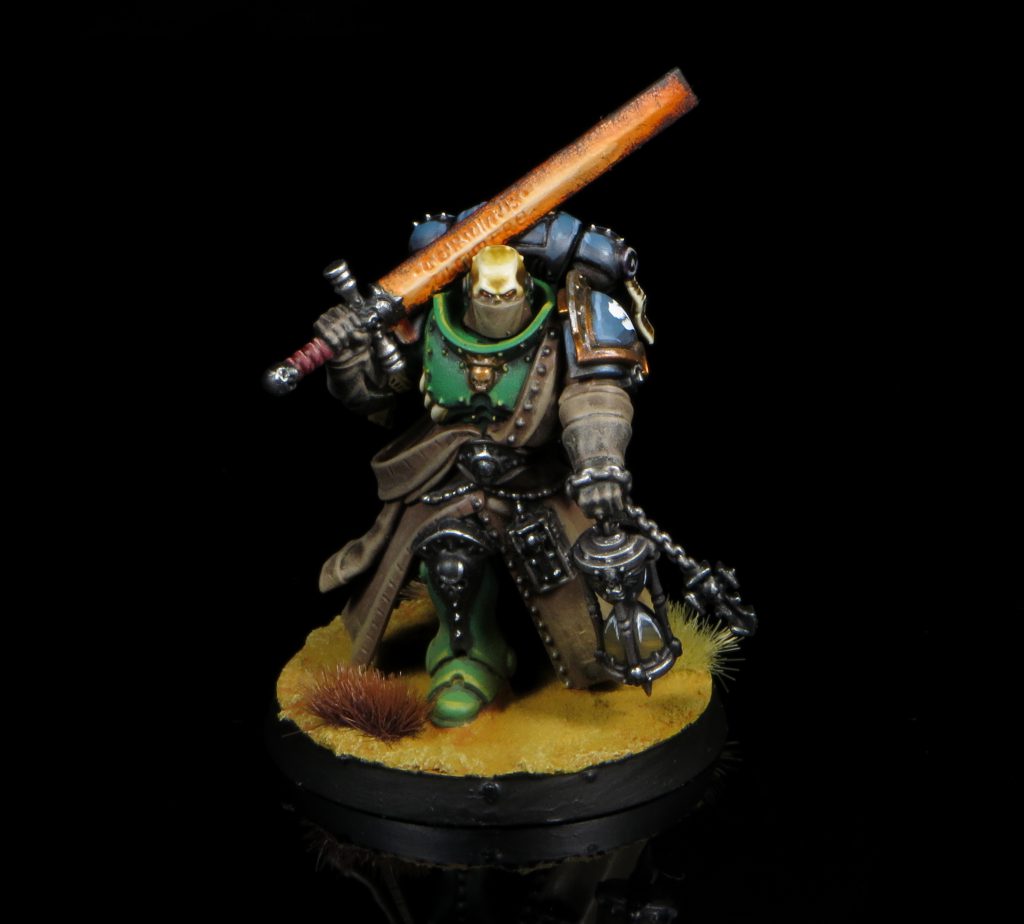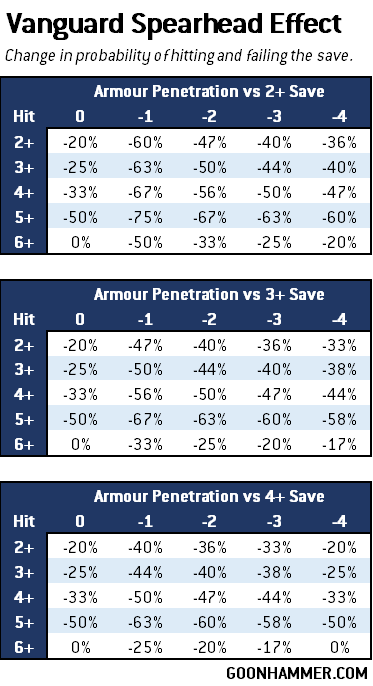This week’s Hammer of Math looks at the effects of the detachment wide rules available in the new Space Marines Codex.
The release of the new Space Marine codex reinforces the theme we first saw in the Tyranid book, with detachments playing the key role in determining how an army will play. In the case of Space Marines, players now have access to a grand total of 12 detachments. The original six (Gladius Task Force as well as the options for Deathwatch, Black Templar, Space Wolves, Dark Angels, and Blood Angels) are now supplemented by options that are analogous to the various core Chapters from the previous edition. You can get a detailed assessment of each detachment in our review, but this article will instead focus on the mathematical effects of each one.

Oath of Moment
Before I deep dive into the effects of each detachment, I wanted to briefly discuss how Oath of Moment has changed. Previously this army-wide bonus allowed the player to re-roll Hit and Wound rolls against one target that was chosen in the Command phase. Oath of Moment now only allows Hit rolls to be re-rolled, which is a significant reduction. Note that the new rule applies to every Space Marine with the Oath of Moment ability, even those using the Index detachments. The change is entirely a function of the Wound roll, with the impact ranging from a 14% reduction in probability for a 2+ to wound all the way down to a 45% reduction for a 6+ to wound. This is a pretty major drop in effectiveness and makes units with Wound roll re-rolls like Aggressors, Eradicators, and Gladiator Lancers more useful.
 Detachment Effects
Detachment Effects
Codex Space Marines includes a total of seven detachments, including a reprint of the Gladius Task Force where the only change was renaming an Enhancement. The Gladius Task Force serves as a good baseline because the detachment rules are all based on altering when a unit is eligible to shoot or charge, as opposed to altering any probabilities. With the exception of the Stormlance Task Force (which allows units to Advance and charge, adding an average of 3.5″ to the charge range), every other detachment modifies the probability of an attack sequence:
- The Anvil Siege Force gives every weapon the [HEAVY] keyword, and gives a +1 to wound bonus on anything that already has the keyword.
- The Ironstorm Spearhead provides a single re-roll that can be used once per phase and can be applied to a Hit roll, Wound roll, or Damage roll.
- The Firestorm Assault Force gives every ranged weapon the [ASSAULT] keyword so they can Advance and shoot, and also gives every ranged weapon +1 to the Strength characteristic when attacking targets within 12″.
- The 1st Company Task Force allows the Wound roll to be re-rolled against the Oath of Moment target once per battle.
- The Vanguard Spearhead shrouds units in the detachment, forcing the opponent to subtract 1 from Hit rolls and applying Benefit of Cover against attacks that are 12″ or more away.

Anvil Siege Force
Adding the [HEAVY] keyword allows a unit to have a +1 bonus to Hit rolls whenever the unit Remained Stationary in the Movement phase. This is compounded by the addition of +1 to Wound rolls for weapons which already had the keyword. They [HEAVY] keyword is used on weapons in a variety of units including Suppressors, Intercessors, Hellblasters, Eliminators, Eradicators, Devastators, and of course the Gladiator Lancer and Repulsor Executioner.
The chart below shows the impact of each bonus. To read it, determine the appropriate Hit and Wound roll targets. Then determine if the bonus is for +1 to Hit or +1 to Hit and Wound. The adjacent column with the delta symbol shows you the improvement in probability relative to no bonus at all.
The bonuses are significant, particularly when you consider the relatively high floor some of these weapons have. Hellblasters are a perfect example. Against anything with a Toughness characteristic of less than 16 the minimum chance of wounding goes from 22% for an unmodified shot to 42% with both bonuses. With something like a Heavy Laser Destroyer against a T12 target the probability of hitting and wounding goes from 44% to 69%, and that’s before any re-rolls are considered.

Ironstorm Spearhead
Instead of a fixed bonus, the Ironstorm Spearhead offers a single re-roll that can be used on the Hit, Wound, or Damage roll. The effect of this bonus is highly dependent on the style of weapon being used. The more concentrated the effect is (say on a large weapon like a Heavy Laser Destroyer), the greater the impact. The graph below shows the change in effect for an ideal scenario; a Heavy Laser Destroyer shooting at a high value target. The presence of a single re-roll increases the median wounds dealt to the target from 6 to 8.

Firestorm Assault Force
In addition to giving everything an average of 3-4″ of extra movement by enabling units to Advance and shoot, when attacking within 12″ the bonus to the Strength characteristic has a chance to improve the probability of wounding when the right threshold is crossed. The weapons that benefit the most are those close to thresholds in T10 and T11, such as melta weapons (S9) las-talons (S10), macro plasma incinerators (S9), or lascannons (S12) against T12 targets. The increase in probability ranges is 0%, 25%, 33%, 50%, and 100% for 2+, 3+, 4+, 5+ and 6+ targets.

1st Company Task Force
Once per battle the entire force can re-roll wounds against the Oath of Moment target, effectively inverting the chart above. The increase in probability is 17%, 33%, 50%, 67%, and 83% for Wound roll targets of 2+ through 6+. The reason that the numbers are higher than the reduction in the chart is because the values in this section are relative to the probabilities without the wound rolls. Compared to the bonuses offered by the Anvil Task Force or the Firestorm Assault Force this detachment seems fairly milquetoast.

Vanguard Spearhead
In contrast to the other detachments listed here, the Vanguard Spearhead is a defensive bonus. The combination of -1 to hit and Benefits of Cover can have a significant impact on the chances of an attack hitting and getting through the save. The modifier reduces the chance to hit by 20%, 25%, 33%, 50%, and 0% for Hit rolls of 2+ through 6+ (6+ is 0% since you can’t get any worse than a 6+ to hit). The improvement to the Save roll has a similar effect, with the chance to survive the attack improved from between 0% (for a Save characteristic of 2+ or 3+ versus AP 0) to the target actually getting a save. The combination of cover and Hit roll penalty can reduce the chance of hitting and failing a save by as much as 75%, although for typical encounters the reduction is closer to 40%.
Final Thoughts
The detachment system is going to offer a lot of flexibility to armies as they get their books, and the number of options available to Space Marines via the new book is considerable. This also doesn’t include the bonuses offered by Enhancements or Stratagems, which can also affect army output considerably. I suspect that a lot of players will gravitate towards the Anvil Task Force assuming they have a lot of [HEAVY] weapons, while players who want to go fast and get in their opponents face will love the Firestorm Assault Force. Personally I still can’t decide which I’m going to field for Atlanta.
Thanks for reading! If you have any questions or comments feel free to drop us a note in the Comments below or email us at contact@goonhammer.com. That’s also the best way to suggest topics for future articles.







You must be logged in to post a comment.